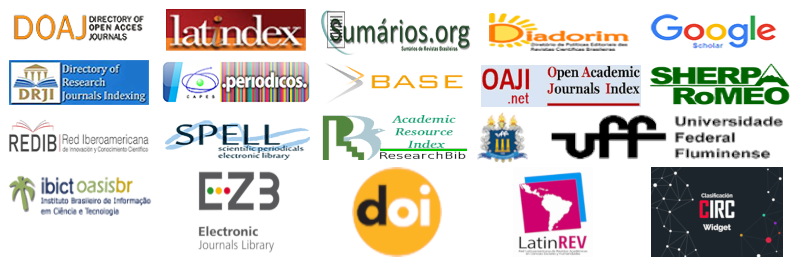The awakening of a nation:
hope, the maturity of institutions and the environment
DOI:
https://doi.org/10.20401/rasi.9.1.771Keywords:
institutions, environment, democracyAbstract
n/a
Downloads
References
Abdalla, M. M. (2018). Crescendo Sustentavelmente numa Linha Editorial Transparente. Revista de Administração, Sociedade e Inovação, 4(1), 1-4. https://doi.org/10.20401/rasi.4.1.228
Acemoglu, D., & Johnson, S. (2005). Unbundling institutions. Journal of Political Economy, 113(5), 949-995. https://doi.org/10.1086/432166
Acemoglu, D., & Robinson, J. (2012). Why nations fail: the origins of power, prosperity and poverty. New York: Crown.
Amaral, M., Fischer, B. B., Silva, S. S., Oliveira, V. C. S., Tello-Gamarra, J., Neves, L. A., Paiva, L. E. B. & Carraro, E. R. (2022). Sobre editoriais, pesquisa científica e depressão coletiva de uma nação sem projeto. Revista de Administração, Sociedade e Inovação, 8(3), 01-05. https://doi.org/10.20401/rasi.8.3.749
Amaral, M., Fischer, B. B., Carvalho, R. S., Oliveira, V. C. S. (2020a). Para que serve o editorial? Para desejar Feliz 2020? Revista de Administração, Sociedade e Inovação, 6(1), 01-04. https://doi.org/10.20401/rasi.6.1.426
Amaral, M., Fischer, B. B., Carvalho, R. S., Oliveira, V. C. S., Silva, S. S., & Carraro, E. R. (2020b). A Crise e a Oportunidade da Pandemia – Por uma Nova Política de Desenvolvimento. Revista de Administração, Sociedade e Inovação, 6(3), 01-06. https://doi.org/10.20401/rasi.6.3.519
Castellacci, F., & Natera, J. (2013). The dynamics of national innovation systems: a panel cointegration analysis of the coevolution between innovative capability and absorptive capacity. Research Policy, 42(3), 579-594. https://doi.org/10.1016/j.respol.2012.10.006
Dahlman, C. (1994). Technology strategy in East Asian developing economies. Journal of Asian Economics, 5(4), 541-572. https://doi.org/10.1016/S1049-0078(10)80010-7
Da Silva, M. D., & Fearnside, P. M. (2022). Brasil: meio ambiente sob ataque no governo Bolsonaro. Amazônia Real. Disponível em: https://amazoniareal.com.br/brasil-meio-ambiente-sob-ataque-no-governo-bolsonaro/ Acesso em 07 de dezembro de 2022.
Freeman, C. (1995). The National System of Innovation in historical perspective. Cambridge Journal of Economics, 19(1), 5-24. https://doi.org/10.1093/oxfordjournals.cje.a035309
Glaeser, E., La Porta, R., Lopez-de-Silanes, F., & Shleifer, A. (2004). Do institutions cause growth? Journal of Economic Growth, 9(3), 271-303. https://doi.org/10.2139/ssrn.556370
Hall, R., & Jones, C. (1999). Why do some countries produce so much more output per worker than others? The Quarterly Journal of Economics, 114(1), 83-116. https://doi.org/10.2139/ssrn.3595
Johnson, B. (1992). Institutional learning. In: Lundvall, B. (ed). National Systems of Innovation, London: Pinter.
March, J., & Olsen, J. (2006). Elaborating the New Institutionalism. In: Rhodes, R., Binder, S., & Rockman, B. (eds.). The Oxford Handbook of Political Institutions. Oxford: Oxford University Press. https://doi.org/10.1093/oxfordhb/9780199548460.001.0001
Nasierowski, W., & Arcelus, F. (2003). On the efficiency of national innovation systems. Socio-Economic Planning Sciences, 37(3), 215-234. https://doi.org/10.1016/S0038-0121(02)00046-0
Nelson, R., & Sampat, B. (2001). Making sense of institutions as a factor shaping economic performance. Journal of Economic Behavior and Organization, 44(1), 31-54. https://doi.org/10.1016/S0167-2681(00)00152-9
Niosi, J. (2002). National systems of innovations are “x-efficient” (and x-effective). Research Policy, 31(2), 291-302. https://doi.org/10.1016/S0048-7333(01)00142-1
North, D. (1990). Institutions, Institutional Change and Economic Performance. Cambridge: Cambridge University Press.
Oliveira, V. C. S., Amaral, M., & Carraro, E. R. (2021). A necessidade contemporânea de se defender o óbvio: a reunião anual da Sociedade Brasileira para o Progresso da Ciência e o fato de que todas as ciências são humanas. Revista de Administração, Sociedade e Inovação, 7(2), 01-06. https://doi.org/10.20401/rasi.7.2.593
Ostrom, E. (2005). Understanding Institutional Diversity. Princeton: Princeton University Press.
Pinto, H., & Pereira, T. (2013). Efficiency of innovation systems in Europe: an institutional approach to the diversity of national profiles. European Planning Studies, 21(6), 755-779. https://doi.org/10.1080/09654313.2012.665033
Rodrik, D. (2000). Institutions for high-quality growth: what they are and how to acquire them. Studies in Comparative International Development, 35(3), 3-31. https://doi.org/10.1007/BF02699764
Ruffoni, J., Fischer, B. B., & Amaral, M. (2021). A Contribuição da Economia Industrial e da Tecnologia Para as Temáticas de Administração, Sociedade e Inovação. Revista de Administração, Sociedade e Inovação, 7(1), 01-06. https://doi.org/10.20401/rasi.7.1.562
Tebaldi, E., & Elmslie, B. (2013). Does Institutional Quality Impact Innovation? Evidence from Cross-Country Patent Grant Data. Applied Economics, 45(7), 887-900. https://doi.org/10.1080/00036846.2011.613777
Whitley, R. (2007). Business systems and organizational capabilities – the institutional structuring of competitive competencies. Oxford: Oxford University Press. https://doi.org/10.1093/acprof:oso/9780199205172.001.0001
Downloads
Published
Issue
Section
License
Copyright (c) 2022 Review of Administration, Society and Innovation

This work is licensed under a Creative Commons Attribution 4.0 International License.
RASI, in accordance with Law No. 9,610 of February 19, 1998, which amends, updates and consolidates Brazilian copyright law and makes other provisions, adopts the following conditions of the Copyright Assignment:
1. RASI maintains, with the transfer of copyrights, the possession of rights over the content published;
2. The author retains his moral rights of the content, including the right to be identified as the author whenever the content is published;
3. Despite the attribution of copyright, the author retains the right to reuse the material in future collections of his own work without encumbrance. The acknowledgments of the previous publication in the RASI are the only requirements in such cases;
4. The author may make photocopies of the content, or distribute it by electronic mail or fax, provided that they are intended for their own classes and for the purpose of meeting research objectives, provided that: (a) such copies are not resold and (b) reference to the original source of the publication and the name of the RASI are clearly indicated on all copies made of the document.











